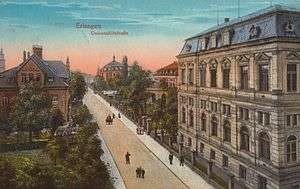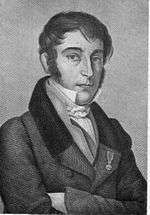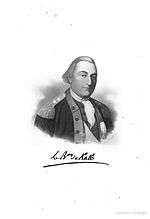Erlangen
| Erlangen | ||
|---|---|---|
|
View over Erlangen, 2012 | ||
| ||
 Erlangen | ||
| Coordinates: 49°35′N 11°1′E / 49.583°N 11.017°ECoordinates: 49°35′N 11°1′E / 49.583°N 11.017°E | ||
| Country | Germany | |
| State | Bavaria | |
| Admin. region | Mittelfranken | |
| District | Urban district | |
| Government | ||
| • Lord Mayor | Florian Janik (SPD) | |
| Area | ||
| • Total | 76.90 km2 (29.69 sq mi) | |
| Population (2015-12-31)[1] | ||
| • Total | 108,336 | |
| • Density | 1,400/km2 (3,600/sq mi) | |
| Time zone | CET/CEST (UTC+1/+2) | |
| Postal codes | 91001–91058 | |
| Dialling codes |
09131, 0911 (OT Hüttendorf), 09132 (OT Neuses), 09135 (OT Dechsendorf) | |
| Vehicle registration | ER | |
| Website | www.erlangen.de | |


Erlangen (German pronunciation: [ˈɛrlaŋən]; East Franconian: Erlang) is a Middle Franconian city in Bavaria, Germany. It is located north-west of Nuremberg at the confluence of the river Regnitz and its large tributary, the Schwabach. Erlangen has more than 100,000 inhabitants.
As of 2015 Erlangen is dominated by the University of Erlangen-Nuremberg and the numerous branch offices of Siemens AG, as well as a large research Institute of the Fraunhofer Society and the Max Planck Institute for the Science of Light. An event that left its mark on the city was the settlement of Huguenots after the revocation of the Edict of Nantes in 1685.
Felix Klein's Erlangen program of 1872, considering the future of research in mathematics, is so called because Klein then taught at the University of Erlangen-Nuremberg.
History
Erlangen was first mentioned in official records in 1002 under the name of Villa Erlangon. In 1361, the village was sold to Emperor Karl IV. Three years later, a city was built close to the village, which in 1374 was given its own mint. In 1398, the municipal rights were confirmed. In 1402, the city came into the possession of the House of Hohenzollern as part of the Principality of Brandenburg-Kulmbach (from 1603 on Brandenburg-Bayreuth), remaining under their rule until 1806. During the four year Napoleonic occupation, Erlangen was the capital of the so-called "Low County" (Unterland) of the principality, encompassing the area until Neustadt an der Aisch and separated from the "High County" (Oberland) by a land corridor. In 1810 it became part of the Kingdom of Bavaria, together with the rest of former Brandenburg-Bayreuth.
While it was still part of Brandenburg-Bayreuth, the first French Huguenot refugees arrived in Erlangen in 1686. Margrave Christian Ernst of Brandenburg-Bayreuth, built a "new town" (Neustadt) for them. In 1706, the old town (just below the site of the annual Bergkirchweih) was almost completely destroyed by a fire, but soon rebuilt. In 1812, the old and new towns were merged into one.
In 1742, Frederick, Margrave of Brandenburg-Bayreuth, founded a university for his royal seat of Bayreuth, but due to the rebelliousness of the local students, the university was transferred to Erlangen. Only later did it obtain the name of "Friedrich-Alexander-University" and become a Prussian state university. Famous students of these times were Johann Ludwig Tieck and Wilhelm Heinrich Wackenroder and Emmy Noether.
Already during the Bavarian municipal reform of 1818, the city was endowed with its own administration. In 1862, the canton administration Erlangen was founded, from which later arose the administrative district of Erlangen. In 1972, this district was merged with the administrative district of Höchstadt. Erlangen became the capital of this newly founded district Erlangen-Höchstadt. During this municipal reform, Erlangen was effectively enlarged considerably, thus in 1974 it had more than 100,000 inhabitants.
Points of interest
- The University of Erlangen-Nuremberg (Friedrich-Alexander-Universität) was founded in 1742 by Frederick, Margrave of Brandenburg-Bayreuth, in the city of Bayreuth, but was relocated to Erlangen the next year. Today, it features five faculties; some departments (Economics and Education) are located in Nuremberg. About 39,000 students study at this university, of which about 20,000 are located in Erlangen.
- The Botanischer Garten Erlangen is a botanical garden maintained by the university.
Bergkirchweih
The Bergkirchweih is an annual beer festival, similar to the Oktoberfest in Munich but smaller in scale. It takes place during the twelve days before and after Pentecost (that is, 49 days after Easter); this period is called the "fifth season" by the locals. The beer is served at wooden tables in one-litre stoneware jugs under the trees of the "Berg", a small, craggy, and wooded hill with old caves (beer cellars) owned by local breweries. The cellars extend for 21 km (14 miles)[2] throughout the hill (the "Berg") and maintain a constant cool underground temperature. Until Carl von Linde invented the electric refrigerator in 1871, this was considered to be the largest refrigerator in Southern Germany.[3]
The beer festival draws more than one million visitors annually. It features carnival rides of high tech quality, food stalls of most Franconian dishes, including bratwurst, suckling pig, roasted almonds, and giant pretzels.
It is commonly known by local residents as the "Berchkärwa" (pronounced "bairch'-care-va") or simply the "Berch", like in "Gehma auf'n Berch!" ("Let's go up the mountain!").
This is an outdoor event frequented and enjoyed by Franconians. Despite a relatively high number of visitors, it is not commonly known by tourists, or people living outside Bavaria.
Districts
- Am Anger
- Alterlangen
- Bruck, pop. 20,000
- Büchenbach
- Burgberg
- Dechsendorf
- Eltersdorf, pop. around 3,200
- Frauenaurach
- Häusling
- Hüttendorf
- Innenstadt
- Kosbach
- Kriegenbrunn
- Neusses
- Röthelheim
- Schallershof/Sonnenblick
- Sieglitzhof/Buckenhofer Siedlung
- Steudach
- Tennenlohe[4]
Historical population
| Year | Population |
|---|---|
| 1495 | 292 |
| 1630 | 550 |
| 1752 | 7,939 |
| 1830 | 9,800 |
| December 1, 1871¹ | 12,500 |
| December 1, 1890¹ | 17,559 |
| December 1, 1900¹ | 22,953 |
| December 1, 1910¹ | 24,877 |
| June 16, 1925¹ | 29,597 |
| June 16, 1933¹ | 32,348 |
| May 17, 1939¹ | 35,964 |
| September 13, 1950¹ | 50,690 |
| June 16, 1961¹ | 69,552 |
| May 27, 1970¹ | 84,110 |
| June 20, 1975 | 100,700 |
| June 30, 1980 | 100,900 |
| June 30, 1985 | 100,000 |
| May 27, 1987¹ | 99,808 |
| June 30, 1997 | 100,700 |
| December 31, 1997 | 100,330 |
| December 31, 1998 | 100,775 |
| December 31, 1999 | 100,750 |
| December 31, 2000 | 100,778 |
| December 31, 2001 | 101,912 |
| December 31, 2002 | 102,198 |
| December 31, 2003 | 102,449 |
| December 31, 2004 | 102,627 |
| December 31, 2005 | 103,426 |
| Largest groups of foreign residents[5] | |
| Nationality | Population (2013) |
|---|---|
| 1,711 | |
| 972 | |
| 792 | |
| 748 | |
| 742 | |
| 660 | |
Mayors of Erlangen
- 1818–1827: Johann Sigmund Lindner
- 1828–1855: Johann Wolfgang Ferdinand Lammers
- 1855–1865: Carl Wolfgang Knoch
- 1866–1872: Heinrich August Papellier
- 1872–1877: Johann Edmund Reichold
- 1878–1880: Friedrich Scharf
- 1881–1892: Georg Ritter von Schuh
- 1892–1929: Theodor Klippel
- 1929–1934: Hans Flierl
- 1934–1944: Alfred Groß (NSDAP)
- 1944–1945: Herbert Ohly (NSDAP)
- 1945–1946: Anton Hammerbacher (SPD)
- 1946–1959: Michael Poeschke (SPD)
- 1959–1972: Heinrich Lades (CSU)
- 1972–1996: Dietmar Hahlweg (SPD)
- 1996–2014: Siegfried Balleis (CSU)
- 2014–present: Florian Janik (SPD)
International relations
Erlangen is twinned with several cities:
 Eskilstuna, Sweden, since 1961.
Eskilstuna, Sweden, since 1961. Rennes, France, since 1964.
Rennes, France, since 1964. Vladimir, Russia, since 1983.
Vladimir, Russia, since 1983. Jena, Thuringia, Germany, since 1987.
Jena, Thuringia, Germany, since 1987. Stoke-on-Trent, United Kingdom, since 1989.
Stoke-on-Trent, United Kingdom, since 1989. San Carlos, Nicaragua, since 1989.
San Carlos, Nicaragua, since 1989. Beşiktaş, Turkey, since 2004.
Beşiktaş, Turkey, since 2004. Riverside, California, US, since 2011.
Riverside, California, US, since 2011.
Further partnerships
Famous residents
Though a small village for much of its history and now only a small city of only 100k inhabitants, Erlangen has made significant contributions to the world, primarily through its many Lutheran theologians, to its University of Erlangen-Nuremberg scholars, and the Siemens AG pioneers in science and technology.



.jpg)
Among its noted residents are:
- Johann de Kalb (1721-1780), - Soldier, War of Austrian Succession, Seven Years' War, Major General in the American Revolutionary War, namesake of many American towns
- Philipp Ludwig Statius Müller (1725-1776), - zoologist, known to the classification of several new species, especially birds
- Eugenius Johann Christoph Esper (1742-1810), - scientist, botanist, first to begin research into Paleopathology
- Johann Schweigger - (1779-1857), chemist, physicist, mathematician, named "Chlorine", and invented the Galvanometer
- August Friedrich Schweigger (1783-1921), - botanist, zoologist, known for taxonomy including the discovery of several turtle species
- Georg Ohm - (1789-1854), German scientist, famous for Ohm's Law regarding electric current, and the measurement unit Ohm
- Karl Heinrich Rau - (1792-1870), economist, published an influential encyclopedia of all "relevant" economic knowledge of his time
- Carl Friedrich Philipp von Martius - (1794-1868), botanist, explorer, famous expedition into Brazil (1817-1820)
- Adolph Wagner - (1835-1917), economist, founding proponent of Academic Socialism and State Socialism
- Paul Zweifel (1848-1927), - gynecologist, proved that the fetus was metabolically active, paving the way for new fetal research
- Emmy Noether - (1882-1935), mathematician, groundbreaking work on abstract algebra and theoretical physics
- Fritz Noether (1884-1941), - mathematician, political prisoner, younger brother of Emmy Noether, imprisoned in Soviet Russia
- Ernst Penzoldt - (1892-1955), artist, famous German author, painter, and sculptor
- Eduard Hauser (soldier) (1895-1961), - German officer, general in World War II,
- Heinrich Welker - (1912-1981), theoretical physicist, made numerous inventions in the early electrical engineering fields
- Rudolf Fleischmann (1903-2002), - scientist, nuclear physicist, member of the Uranium Club, theorist on isotope separation
- Bernhard Plettner - (1914-1997), electrical engineer and Business Administration, CEO for Siemens AG (1971-1981)
- Helmut Zahn (1916-2004), - scientist, chemist, one of the first to discover the properties of Insulin
- Walter Krauß (1917-1943), - Luftwaffe officer
- Hans Lotter (1917-2008), - officer in World War II, escaped from POW camp and wrote memoirs about it
- Georg Nees - (1926-2016), Graphic Artist, expanded ALGOL computer language, pioneer in digital art and sculptures
- Elke Sommer - (born 1940), entertainer, Golden Globe Award winning actress from television and film, early Playboy playmate
- Heinrich von Pierer - (born 1941), Business Administration, CEO for Siemens AG (1992-2005), advisor to numerous governmental figures
- Gerhard Frey - (born 1944), mathematician, worked on Elliptic Curve and helped prove Fermat's Last Theorem
- Karl Meiler - (1949-2014), tennis player, moderately successful in Doubles Tennis in the 1970s.
- Karlheinz Brandenburg - (born 1954), sound engineer, contributor to the invention of the format MPEG Audio Layer III, or MP3
- Klaus Täuber - (born 1958), footballer, played for several Bundesliga teams from the mid 1970s-1980s, managed at lower levels
- Lothar Matthäus - (born 1961), German Football legend, World Cup Winning Captain, Bayern Captain, first FIFA World Player of the Year
- Willi Kalender - medical physicist, pioneer in CT Scan technology and research into numerous diseases
- Jürgen Teller - (born 1964), fine art and fashion photography, worked for numerous magazines and designers, often with Björk
- Hisham Zreiq - (born 1968), award-winning Palestinian Christian Independent filmmaker, poet and visual artist.
- Peter Wackel - (born 1977), singer, with 6 albums and over 25 singles, he has a niche singing Schlager musik
- Flula Borg - (born 1982), entertainer, DJ, hip-hop artist, internet sensation, film critic
For a more complete list, please check out Category:People from Erlangen
References
- ↑ "Fortschreibung des Bevölkerungsstandes". Bayerisches Landesamt für Statistik und Datenverarbeitung (in German). June 2016.
- ↑ "Im Untergrund von Erlangen: Die Kellerführung vom Entlas Keller // hombertho.de // 2010, Bergkerwa, Bier, Erlangen, Fotos, Kellerführung, Mai, Party". Hombertho.de. 2010-04-18. Retrieved 2012-07-23.
- ↑ "Der Entlaskeller - Kellerführungen". Entlaskeller.de. Retrieved 2012-07-21.
- ↑ "Erlangen, Ortsteil Tennenlohe". Fen-net.de. 1972-01-07. Retrieved 2012-07-21.
- ↑ "Ausländer nach Staatsangehörigkeit". Stadt Erlangen. Retrieved 2014-10-25.
External links
| Wikimedia Commons has media related to Erlangen. |
| Wikivoyage has a travel guide for Erlangen. |
- Official website
- erlangeninfo.de Erlangen City Guide
- University of Erlangen
- Ferris Barracks - former US Army Kaserne in Erlangen

